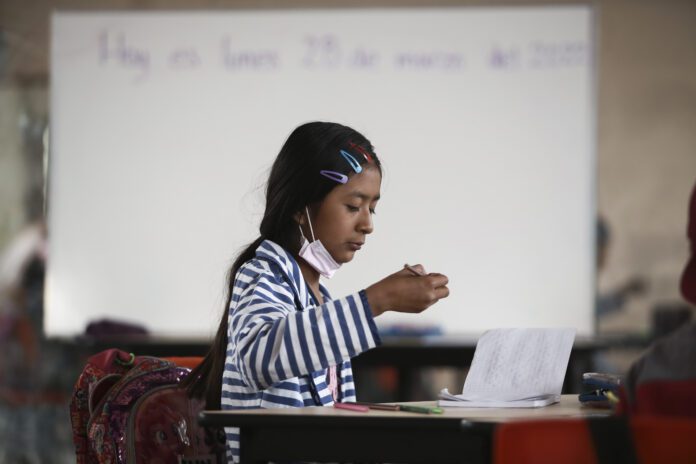“Education is important so that they can develop as people and they’ll be able to defend themselves from whatever life will put before them,” Lucia said as she made breakfast in the small communal kitchen at the shelter, where the family had lived for nine months.
Her daughter Carol, 8, already had on her mask and pink backpack, ready to run ahead of the pack as soon as the school bus’s arrival was announced.
About three dozen children from Casa Oscar Romero and another religious-run shelter attend Casa Kolping. First to third graders like Carol gather in one classroom, and fourth to sixth graders like Victor meet across the hallway in a large room whose windows frame views of El Paso’s mountains.
Across the border, Victor imagines, schools will be “big, well-cared for,” and will help him reach his goal of becoming an architect. He already practices drawing detailed houses, when he can find paper.
“If you ask the kids, their biggest dream is to cross to the United States,” said teacher Yolanda Garcia.
Many parents see no point in enrolling children in school in Mexico, where they don’t plan to stay. Also, many public educators are reluctant to admit migrant students, for fear of losing teacher slots if class sizes shrink when they leave suddenly, said Dora Espinoza, a primary school principal in Ciudad Juarez. She actively reaches out to families, including at a shelter two blocks from her classrooms.
“Why all that paperwork if the kid is going to be gone in two weeks” is one argument that makes promoting child migrant education such a challenge, said Paola Gómez, Mexico’s education officer for UNICEF. The U.N. child protection agency helps finance Casa Kolping as a pilot program, where attendance gets a kid transferable credit for both Mexican and U.S. schools.
In addition to uncertainty, poverty and discrimination keep nearly half of refugee children from school worldwide, according to the United Nations refugee agency, UNHCR.
But the biggest barrier is insecurity. Hounded by violence in their hometowns and preyed upon by gangs along the journey — often right up to a shelter’s doors — many parents are afraid to let children out of their sight.
The faith-run programs address that by providing secure transportation, as in the case of Casa Kolping, or bringing instructors directly to the migrants, as in the case of another Ciudad Juarez shelter, Buen Samaritano, Spanish for good Samaritan.
Still, the children take serious traumas with them to the classroom.
“‘Teacher, I’m here because they murdered my parents.’ They tell it in detail, children don’t cover anything up,” said Samuel Jimenéz, a teacher at Buen Samaritano on a recent blustery afternoon. “In the moment they’re here, we can take them out of that reality. They forget it.”

